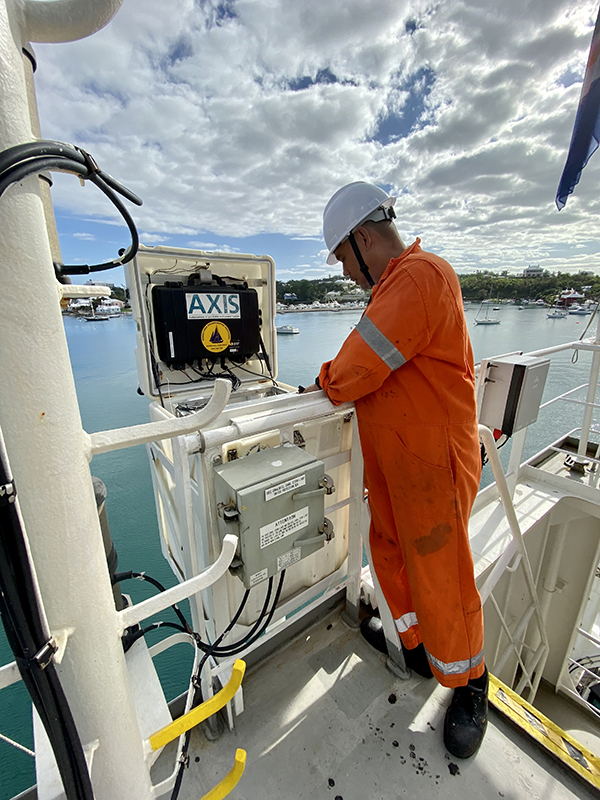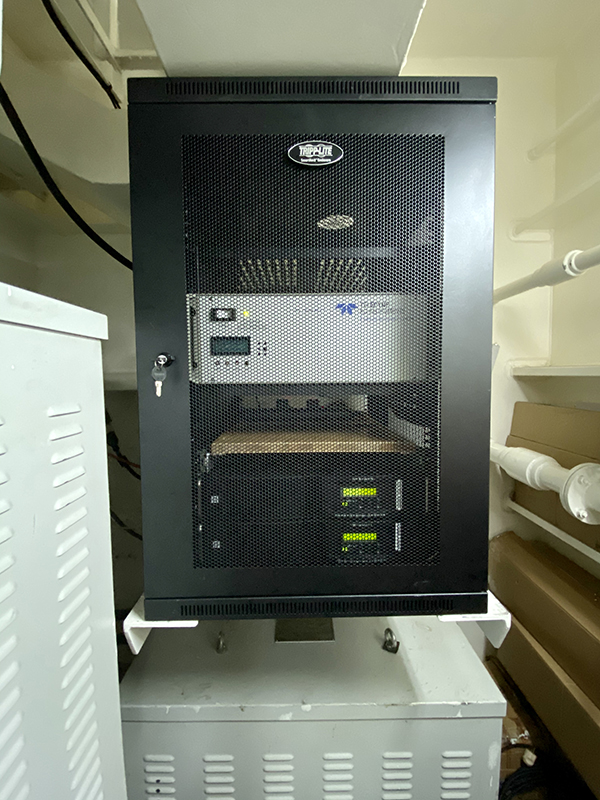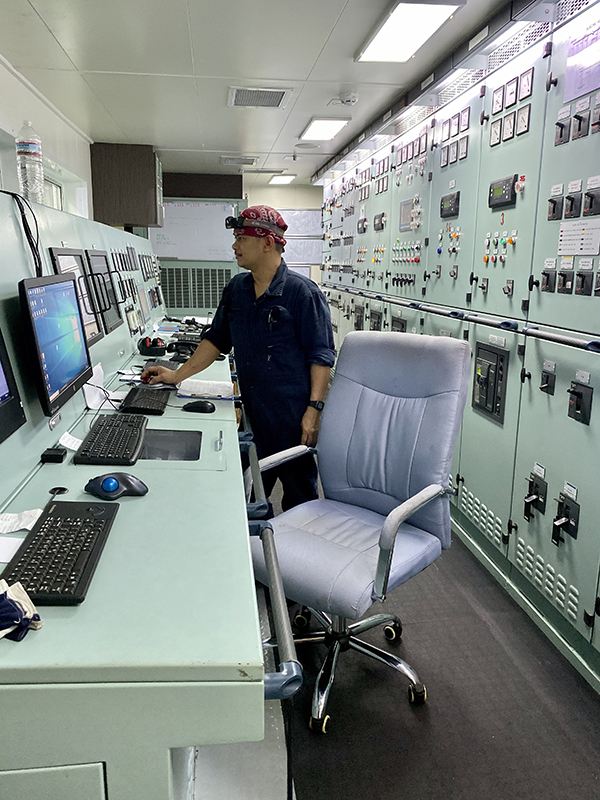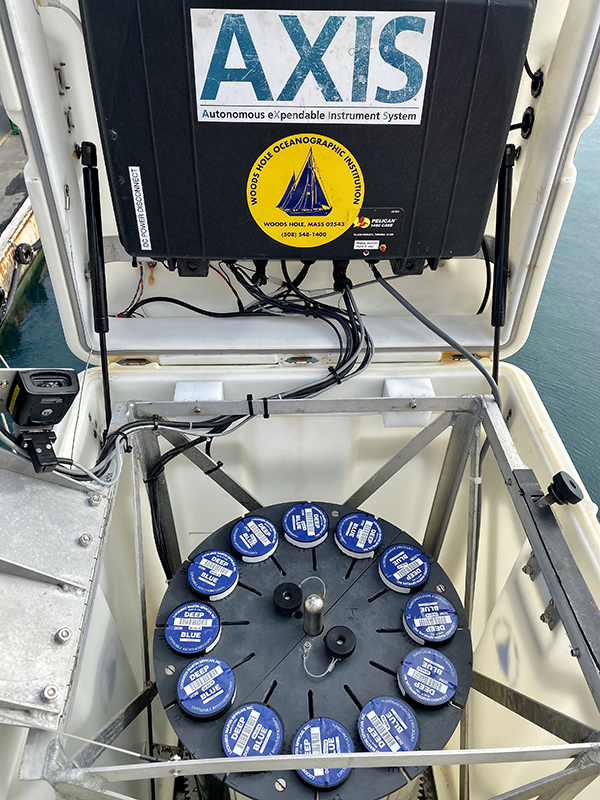Oleander Project Ushers In New Era Of Research
Despite the ongoing Covid-19 pandemic, the container ship Oleander continues to work as a “ship of opportunity that acquires important ocean measurements during its weekly voyages between Bermuda and the United States.”
A spokesperson said, “As Bermuda shuttered international travel and local business in response to the COVID-19 pandemic this spring, three container ships continued to deliver a critical supply of food and consumer goods to the island.
“One of these vessels, the Oleander, has been quietly serving the public and the scientific community in another important way for several decades — as a volunteer ship of opportunity that acquires important ocean measurements during its weekly voyages between Bermuda and the United States.
An Autonomous eXpendable Instrument System [AXIS] unit attached to the rail of the ship releases an eXpendable BathyThermograph [XBT] probe to collect data on ocean climate and circulation. Prior to the development of the AXIS, these probes had to be manually released by a crew member every hour, for up to 36 hours at a time. The AXIS system contains a carousel that can be loaded with up to 12 probes, then programmed to release them at specific times or locations. Developed by Woods Hole Oceanographic Institution [WHOI], the first AXIS prototype was tested at sea over the past 12 months aboard the M/V Oleander:
“The Oleander Project involves ocean scientists from six research institutions and the Bermuda Container Line [BCL]. Led by oceanographers Ruth Curry and Nick Bates at the Bermuda Institute of Ocean Sciences [BIOS], the Oleander Project operates in collaboration with a team of researchers from the University of Rhode Island, Stony Brook University in New York, the National Oceanic and Atmospheric Administration [NOAA], the University of Hawaii, and Woods Hole Oceanographic Institution in Massachusetts.
“Since 1992, this collaborative arrangement has capitalized on Oleander’s weekly round-trip passages between Port Elizabeth, New Jersey and Hamilton, Bermuda to collect valuable data about the state of the North Atlantic Ocean.
“Utilizing specialized instruments embedded in the ship’s hull, scientists measure currents—such as the Gulf Stream—in addition to ocean temperatures and carbon dioxide levels to determine how these vary by season and year. As data are acquired over multiple years, scientists are able to detect long-term trends as the planet’s climate system changes.”
The OS 38 ADCP deck units stored onboard the M/V Oleander outside the engine control room. This oceanographic instrument is mounted in the hull of the ship and measures upper ocean currents relative to the ship’s speed. They are designed to collect data over different depth ranges. Additionally, a system to measure carbon dioxide concentrations in the surface water is being installed to enable scientists to monitor ocean acidification, the long-term decrease in the ocean’s pH caused by the uptake of carbon dioxide from the atmosphere:
Ms. Curry said, “Over the last three decades, the data have shown significant warming of 1.8 to 2.1 degrees Fahrenheit [1.0 to 1.2 degrees Celsius] of ocean temperatures between the edge of the U.S. continental slope and Bermuda down to depths of 1200 feet [400 meters].
“Warming on the U.S. continental shelf since 2002 has been even greater, with notable shifts in marine ecosystems as a consequence. There have, however, been no significant trends measured in the strength of the Gulf Stream flow.” Significant trends are defined as those in excess of a 15% change from the background variability.”
The spokesperson said, “In March, BCL welcomed the new 393-foot [120 meter] motor vessel [M/V] Oleander to its fleet to replace the M/V Oleander III, which was sold to new owners in Turkey after making the transit between Bermuda and the U.S. for 29 years. With the arrival of the new ship, scientific leadership of the program has been transferred to BIOS researchers who will steward it into the future.”
“The new custom-built container vessel is longer and wider, with new design features to improve heavy weather performance and accommodate Bermuda’s ongoing and future needs,” said Barry Brewer, the president and chief executive of the Neptune Group, the owners of Bermuda Container Line.
The spokesperson said, “The new ship took three years to design and build, and includes a completely different bow shape that allows the ship to better handle the rough weather at sea during winter in the North Atlantic Ocean.
Crew of the M/V Oleander working in the ship’s engine control room:
“The original ship was outfitted with a suite of instruments that operated autonomously while the ship transited back and forth: an Acoustic Doppler Velocity Profiler [ADCP], which measures currents down to an approximate depth of 2,000 feet [600 meters]; a thermosalinograph [TSG] that measures temperature and salinity in the surface waters; and an Autonomous Expendable Instrument System [AXIS] that allows probes to be automatically launched along the vessel’s route and obtain records of ocean temperatures down to depths of 3,000 feet [900 meters].
“The new ship is equipped with the same TSG and AXIS systems, but now carries two separate ADCPs designed to collect data over different depth ranges. One reaches depths of 4,000 feet [1,200 meters] while the other is attuned to shallower waters from the surface down to 650 feet [200 meters].
“Additionally, a system to measure carbon dioxide concentrations in the surface water is being installed under the direction of BIOS senior scientist and director of research Nick Bates. This will enable scientists to monitor ocean acidification, the long-term decrease in the ocean’s pH caused by the uptake of carbon dioxide from the atmosphere.
“The sum of these measurements are processed each week at BIOS and relayed to data assembly centers in the U.S. and then freely distributed through NOAA’s websites to researchers, forecasters, and the public.”
“The new ship and its complement of instruments will allow the Oleander Project to continue monitoring the strength and variability of the Gulf Stream, but in greater detail,” Ms. Curry said.
“We want to publically acknowledge and thank the owners and operators of the M/V Oleander for supporting these activities, as well as the National Science Foundation, NOAA, and the Office of Naval Research for the grants and contracts to operate and maintain this extremely important program.”
Read More About
Category: All, Environment, News






What a wonderful Improvement since I retired in 2000 Congradulations keep up the good work